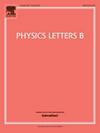画出介子和质子的质量分布
IF 4.5
2区 物理与天体物理
Q1 ASTRONOMY & ASTROPHYSICS
引用次数: 0
摘要
在不参考深度虚康普顿散射数据的情况下,利用光前全息模型说明了由价夸克分布函数(DF)和电磁形状因子(FH)构造强子零偏态广义部子分布(GPD)的代数方案。由GPD计算出的强子质量分布引力形式因子AH比FH更难;而且,对于每个强子,相关的质量密度分布比类似的电荷分布更紧凑,每个介子的近核密度都大于它的质子伙伴。这些特征与所采用的方案无关。本文章由计算机程序翻译,如有差异,请以英文原文为准。
Sketching pion and proton mass distributions
A light-front holographic model is used to illustrate an algebraic scheme for constructing a representation of a hadron's zero-skewness generalised parton distribution (GPD) from its valence-quark distribution function (DF) and electromagnetic form factor, , without reference to deeply virtual Compton scattering data. The hadron's mass distribution gravitational form factor, , calculated from this GPD is harder than ; and, for each hadron, the associated mass-density profile is more compact than the analogous charge profile, with each pion near-core density being larger than that of its proton partner. These features are independent of the scheme employed.
求助全文
通过发布文献求助,成功后即可免费获取论文全文。
去求助
来源期刊

Physics Letters B
物理-物理:综合
CiteScore
9.10
自引率
6.80%
发文量
647
审稿时长
3 months
期刊介绍:
Physics Letters B ensures the rapid publication of important new results in particle physics, nuclear physics and cosmology. Specialized editors are responsible for contributions in experimental nuclear physics, theoretical nuclear physics, experimental high-energy physics, theoretical high-energy physics, and astrophysics.
 求助内容:
求助内容: 应助结果提醒方式:
应助结果提醒方式:


